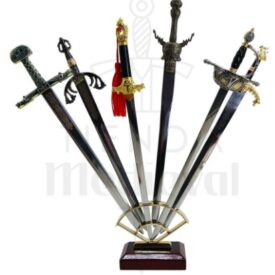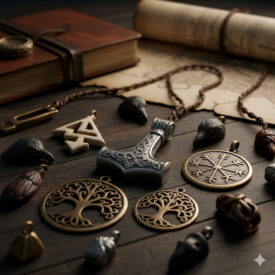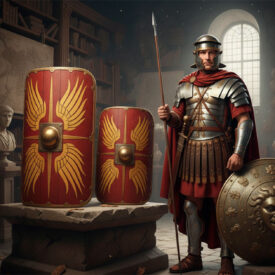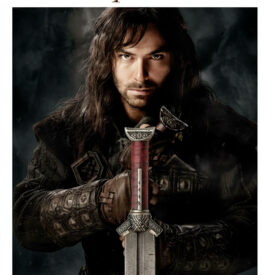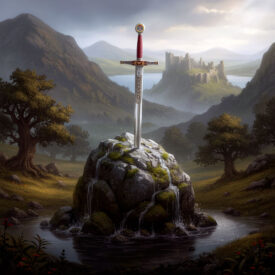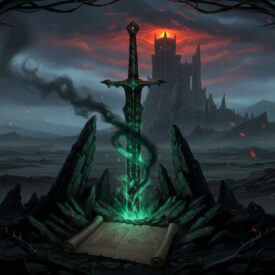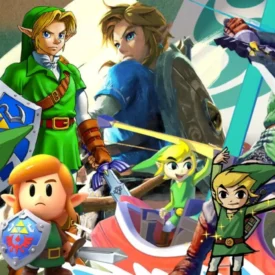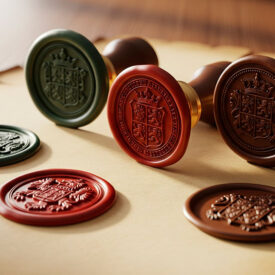What do the clamor of an oppressed crowd, the gleam of steel, and the giant letter Z inscribed in the wood of a corrupt ruler have in common? The answer lies in Zorro’s sword: a weapon that is not just metal and blade, but a seal of identity, a symbol of justice, and a piece of craftsmanship that has endured from the pages of 1919 to modern cinematic productions.
In this article, you will discover how Zorro’s swords evolved over a century of adaptations, what technical and aesthetic elements define them, how modern replicas were forged in traditional Toledo workshops, and why this weapon continues to ignite the imagination of spectators and historical fencing enthusiasts.
Essential Chronology of Zorro and His Sword
Placing milestones in time helps to understand how the sword became an emblem. This chronology gathers the most relevant moments about the character and his weapon:
- 1821–1846 (Narrative Setting): The classic story places Don Diego de la Vega in Alta California during the Mexican Era, a period that shapes the costumes, weapons, and social context of his duels.
- 1919: Johnston McCulley creates the character in the short novel that will give rise to the legend of Zorro and his iconic weapon.
- 1920: Douglas Fairbanks stars in the first cinematic adaptation, The Mark of Zorro, which solidifies the hero’s visual iconography and popularizes his attire and equipment.
- Subsequent Decades: The character reappears in comics, radio series, and films, with details of his sword varying according to the era and audience.
- 1990–1993: The series starring a more modern Zorro maintains the sword as a central element of action and symbolism.
- 2007: The telenovela El Zorro: la espada y la rosa (Zorro: The Sword and the Rose) once again positions the weapon as a dramatic leitmotif in a romantic and televised version.
- 21st Century: Recent productions and the Amazon Prime series introduce artisanal replicas and collaborations with traditional swordsmiths to achieve aesthetic and functional pieces, such as the sword created in Toledo by master swordsmith Antonio Arellano.
The Sword as the Hero’s Seal: Symbolism and Design
Zorro’s sword is not merely a combat tool: it is a visible emblem of Don Diego’s dual identity and his moral pact with justice. Its presence in every scene marks the contrast between imposed order and the popular justice defended by the masked outlaw.
From a design perspective, Zorro’s swords are often inspired by the bladed weapons characteristic of 19th-century Spanish America: long swords, with blades suitable for cuts and thrusts, and guards that protect the swordsman’s hand. In modern adaptations, functional details have been added—grilles, curved quillons, flat loops—that combine aesthetics and safety for the performers.
Recurring elements in the hilt
- Grille-type guards: Protect the hand and add visual character.
- Curved quillons: Decorative elements that also increase protection.
- Pear-shaped pommel: Helps balance the ensemble.
- Flat loop or knuckle guard: Characteristic in some versions to prevent entanglement with capes.
These features are repeated in many replicas and on-set versions, although their execution and proportions vary according to the aesthetics of each adaptation.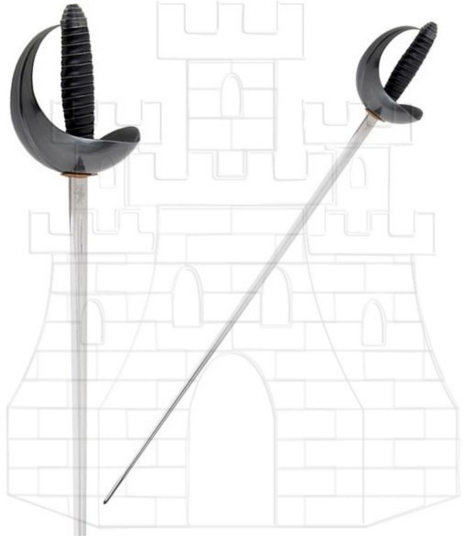
What were swords like historically and what changes did they undergo for fiction?
Swords of the era and region in which the story is set were usually hybrids between foils and cutting swords: long, flexible blades, with a guard that allowed for both fencing and defense in mounted or foot combat. For fiction, however, there are three common lines of modification:
- Aesthetic stylization: Proportions and ornaments that stand out on screen.
- Safety adjustments: Reduced edges, more resistant alloys, and balanced versions for stunt doubles.
- Multiplicity of versions: Creation of different replicas—martial replica, steel replica for detailed shots, and soft replica for choreographies.
Technique and utility in action scenes
In film and television, Zorro’s sword must fulfill a dual function: to be aesthetically faithful to the character and to withstand the wear and tear of the scenes. For this reason, workshops work in conjunction with action coordinators to design variants adapted to each use.
Comparison: Sword Specifications in Different Adaptations
The following table compares approximate characteristics taken from cinematic, television versions, and modern replicas to offer a clear vision of how the weapon changes according to the production.
| Adaptation | Approximate Length | Estimated Weight | Notes |
|---|---|---|---|
| Original Novel (1919) | ~90 cm (~35.4 in) | ~1.1–1.3 kg (~2.4–2.9 lbs) | Described as a long sword, more symbolic than technical. |
| The Mark of Zorro (1920) | ~85–95 cm (~33.5–37.4 in) | ~1–1.4 kg (~2.2–3.1 lbs) | Classic cinematic hero design, greater stylization. |
| 1990–1993 Series | ~88–92 cm (~34.6–36.2 in) | ~1.0–1.3 kg (~2.2–2.9 lbs) | Balance between television aesthetics and safe handling for actors. |
| Modern Series / Amazon Prime | ~90 cm (~35.4 in) | ~1.2 kg (~2.6 lbs) | Artisanal creations with specific versions for combat and cameras. |
- Original Novel (1919)
-
- Blade Length: ~90 cm (~35.4 in)
- Use: Dramatic and symbolic element.
- The Mark of Zorro (1920)
-
- Blade Length: 85–95 cm (~33.5–37.4 in)
- Use: Stylized cuts and thrusts for silent films.
- Modern Series
-
- Blade Length: ~90 cm (~35.4 in)
- Use: Versatility: action scenes and close-ups.
Forging, Craftsmanship, and the Toledo School
Toledo has been a center of excellence in the manufacture of bladed weapons for centuries. In the 21st century, this tradition has found new paths: certified artisans who apply ancestral techniques to contemporary commissions, preserving traditional knowledge and adapting it to the demands of cinema.
ఒక प्रमुख नाम हाल के अनुकूलन में Antonio Arellano, एक टोलेडो मास्टर स्वॉर्डस्मिथ है जिसने ऑडियोविजुअल प्रस्तुतियों के लिए तलवारें बनाने में भाग लिया है। अरेलानो और अन्य कारीगर पारंपरिक तरीकों – स्टील का चयन, हथौड़े से फोर्जिंग, टेम्परिंग और एनिंग – को आधुनिक समाधानों के साथ जोड़ते हैं ताकि सुरक्षित और सुंदर टुकड़े प्राप्त किए जा सकें।
Traditional techniques (summary)
- Material selection: Appropriate steels for tempering and controlled bending.
- Manual forging: Precise hammer blows to homogenize the structure.
- Tempering and annealing: Balance between sharpness and toughness.
- Finishes and hilts: Work in wood, leather, wires, and bluing of the knuckle guard for durability and aesthetics.
Adaptation for filming: safety without losing authenticity
On set, the goal is not to create dangerous weapons: the priority is the safety of the actor and the crew. That’s why multiple versions of Zorro’s sword are built: one for close-ups (real metal, sharpened only for controlled effects), another for choreographies (dull edge or special alloy), and props (light steel or composite materials).
Functional details—such as reducing the size of loops or softening edges—prevent tangles with capes or accidental blows. In some projects, up to three different versions were designed for the same scene to improve mobility without sacrificing aesthetics.
The sword in narrative: duels, sign, and legacy
Beyond technique, Zorro’s sword functions as dramatic language. A Z marked with steel on clothing or a tyrant’s insignia is the hero’s signature; the way he wields the sword, his posture, and his style reveal his training and nobility.
In the tradition of the masked hero, the sword symbolizes the responsibility to act and the line that separates legitimate justice from vengeance. This ambivalence makes it an object of fascination for popular culture historians and historical reenactors alike.
Basic maintenance and conservation of replicas
A well-maintained replica retains its appearance and functionality. There are different recommended products depending on the type of storage and the sword’s material. Practical information is included below (more detailed in the frequently asked questions section):
- Cleaning: Dry the metal after use, avoid moisture and saline residues.
- Oiling: Apply protective oil to prevent oxidation.
- Storage: Avoid prolonged contact with damp textiles and use breathable covers.
Quick technical comparison
When comparing replicas and exhibition pieces, look at these key parameters:
- Blade length (influences technique and aesthetics).
- Weight and balance (determinants for use in choreographies).
- Material (carbon steel vs. stainless steels and alloys).
- Finish (blued, polished, or aged depending on the desired effect).
Zorro’s sword, its forging, and its history
What specific characteristics does Zorro’s sword have in the new Amazon Prime series?
Zorro’s sword in the new series has a length of 90 cm (35.4 inches), a weight of 1.2 kg (2.6 lbs), and a design that combines originality with classic elements of swords from that era. It features a flat loop on the hilt, two curved quillons (one towards the blade and one towards the pommel), and a third quillon on the loop. The pommel is pear-shaped and flat, and the entire guard is blued black. Additionally, the sword is designed to be functional and safe for use in action scenes, with adequate balance and sufficient strength to withstand blows and falls. Three versions were also made to improve mobility in battle, reducing the size of the loops to prevent them from getting entangled with Zorro’s cape.
How does Zorro’s sword differ from other film and television swords?
The Zorro sword differs from other film and television swords mainly due to its design, which combines classic and functional elements with a specific artisanal finish: it has an approximate length of 90 cm (35.4 inches), a balanced weight of 1.2 kg (2.6 lbs), and its guard is blued black with a flat, pear-shaped pommel. Furthermore, it is a loop sword with a grille and quillons that reflect a balance between historical authenticity and an original design unique to the series, handmade by a master artisan, which gives it a unique character and high quality in its manufacture.
In contrast, many film swords tend to have more exaggerated or stylized designs, with the priority on aesthetics for the screen rather than actual combat functionality. For example, some cinematic swords are unrealistically large, excessively decorated, or feature impossible elements in reality, while Zorro’s sword maintains a balance between realism, functionality, and a clear visual identity tied to its character.
What traditional techniques are used in forging Toledo swords?
Traditional techniques in forging Toledo swords include careful selection of steel, heating to high temperatures (around 1200°C or 2192°F), manual forging by hammer blows to shape the blade, followed by a tempering process (rapid cooling in oil) and annealing to balance hardness and toughness. In addition, the “iron soul” technique is employed, which involves inserting a soft iron sheet inside a hard steel blade to combine lightness and strength. Finally, the sword is polished by hand to achieve a sharp edge and a characteristic shine.
Other important techniques include artisanal work on the hilt (using noble woods and materials such as leather or wire for the wrapping), the manufacture and riveting of the pommel and crossguard, and the final assembly of all pieces to ensure firmness and balance. The mastery of Toledo blacksmiths lies in their precise hammering and tempering, secrets passed down through generations.
What other fictional characters have used swords forged in Toledo?
Other fictional characters who have used swords forged in Toledo include Rodrigo, a character from the television series «Toledo, cruce de destinos» (Toledo, Crossroads of Destinies), whose sword was artisanally crafted in Toledo with forged carbon steel. Additionally, Toledo swords are famous for being present in historical television series and films such as «Águila Roja» (Red Eagle), «Isabel», «Carlos, rey y emperador» (Charles, Emperor and King), «Toledo», and «Capitán Trueno» (Captain Thunder), although specific character names are not mentioned in these cases.
Historically, Toledo swords are also associated with legendary characters like El Cid Campeador, whose swords Tizona and Colada are classic examples of swords forged in Toledo, although they are historical-literary characters rather than strictly fictional.
| Type of Oil | Main Characteristics | Recommended Use |
|---|---|---|
| Mineral oil | High penetration, does not degrade or attract dirt | Regular protection and maintenance |
| Camellia oil | Natural, acid-free, non-volatile | Antioxidant protection, lubrication |
| Lithium grease | Dense, durable, does not evaporate | Prolonged storage, protection |
- Mineral oil
-
- Characteristics: High penetration, does not degrade or attract dirt
- Recommended Use: Regular protection and maintenance
- Camellia oil
-
- Characteristics: Natural, acid-free, non-volatile
- Recommended Use: Antioxidant protection, lubrication
- Lithium grease
-
- Characteristics: Dense, durable, does not evaporate
- Recommended Use: Prolonged storage, protection
Zorro’s Sword Today: Legacy, Replicas, and Presence in Popular Culture
Today, Zorro’s sword lives in several dimensions: on screens as a dramatic tool, in workshops as a work of craftsmanship, and in the homes of fans as a replica that tells stories. Its appeal lies precisely in this mix of technical authenticity and symbolic power.
When analyzing Zorro’s swords, we find a common thread: the search for balance between historical reality and narrative needs. This balance explains why traditional Toledo artisans participated in modern productions, providing knowledge and quality control that guarantee beautiful and safe pieces.
Century after century, the sword remains Zorro’s signature: a gesture that goes far beyond the action scene; it is a call to bravery and justice in a world that, at times, needs inspiring symbols.
VIEW MORE MOVIE SWORDS | VIEW OFFICIAL ZORRO SWORD | VIEW ZORRO SWORD


